child restraint CHEVROLET VENTURE 2000 1.G User Guide
[x] Cancel search | Manufacturer: CHEVROLET, Model Year: 2000, Model line: VENTURE, Model: CHEVROLET VENTURE 2000 1.GPages: 429, PDF Size: 3.04 MB
Page 69 of 429
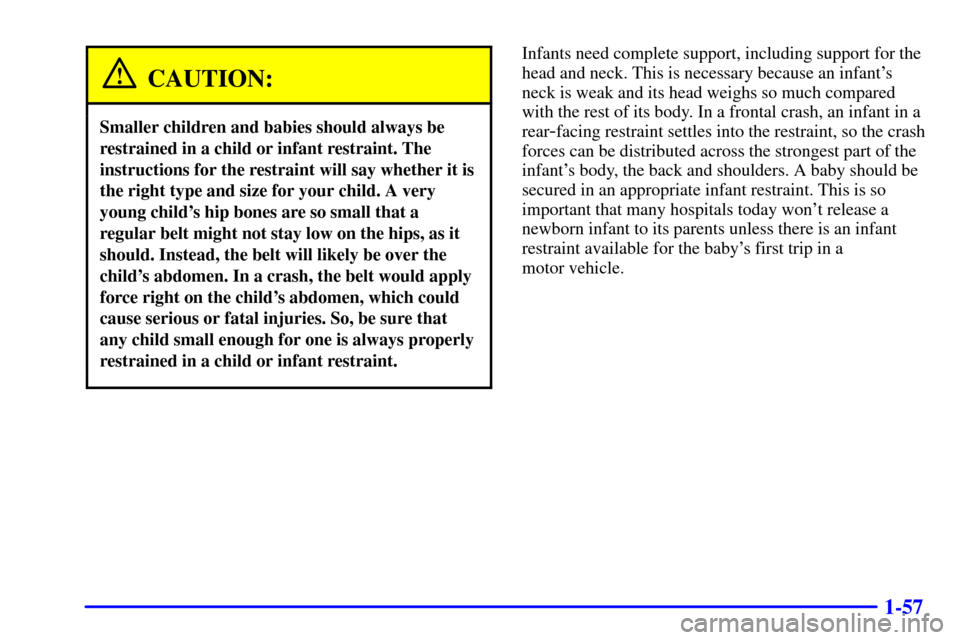
1-57
CAUTION:
Smaller children and babies should always be
restrained in a child or infant restraint. The
instructions for the restraint will say whether it is
the right type and size for your child. A very
young child's hip bones are so small that a
regular belt might not stay low on the hips, as it
should. Instead, the belt will likely be over the
child's abdomen. In a crash, the belt would apply
force right on the child's abdomen, which could
cause serious or fatal injuries. So, be sure that
any child small enough for one is always properly
restrained in a child or infant restraint.
Infants need complete support, including support for the
head and neck. This is necessary because an infant's
neck is weak and its head weighs so much compared
with the rest of its body. In a frontal crash, an infant in a
rear
-facing restraint settles into the restraint, so the crash
forces can be distributed across the strongest part of the
infant's body, the back and shoulders. A baby should be
secured in an appropriate infant restraint. This is so
important that many hospitals today won't release a
newborn infant to its parents unless there is an infant
restraint available for the baby's first trip in a
motor vehicle.
Page 71 of 429
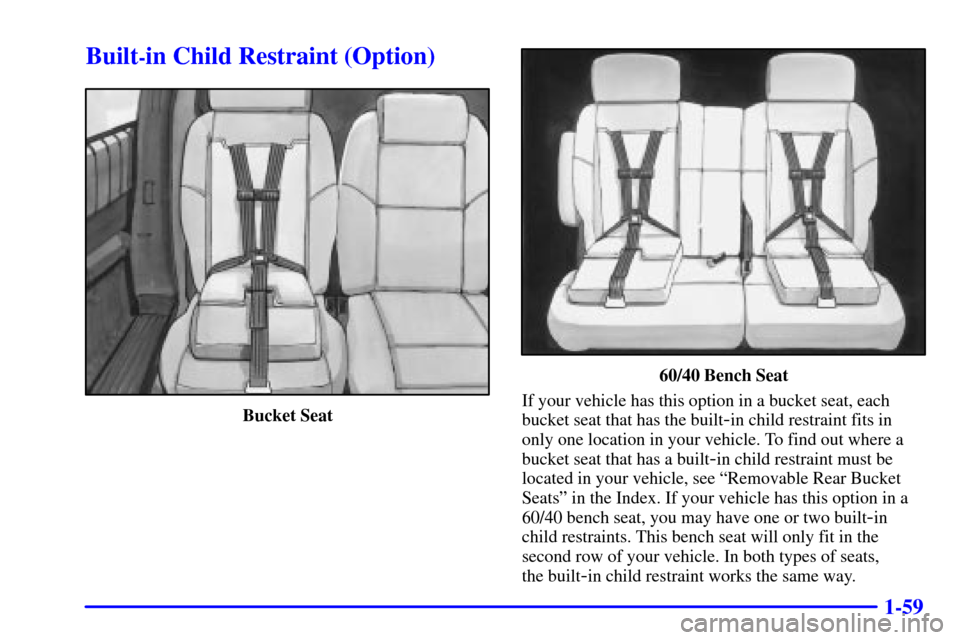
1-59
Built-in Child Restraint (Option)
Bucket Seat
60/40 Bench Seat
If your vehicle has this option in a bucket seat, each
bucket seat that has the built
-in child restraint fits in
only one location in your vehicle. To find out where a
bucket seat that has a built
-in child restraint must be
located in your vehicle, see ªRemovable Rear Bucket
Seatsº in the Index. If your vehicle has this option in a
60/40 bench seat, you may have one or two built
-in
child restraints. This bench seat will only fit in the
second row of your vehicle. In both types of seats,
the built
-in child restraint works the same way.
Page 72 of 429
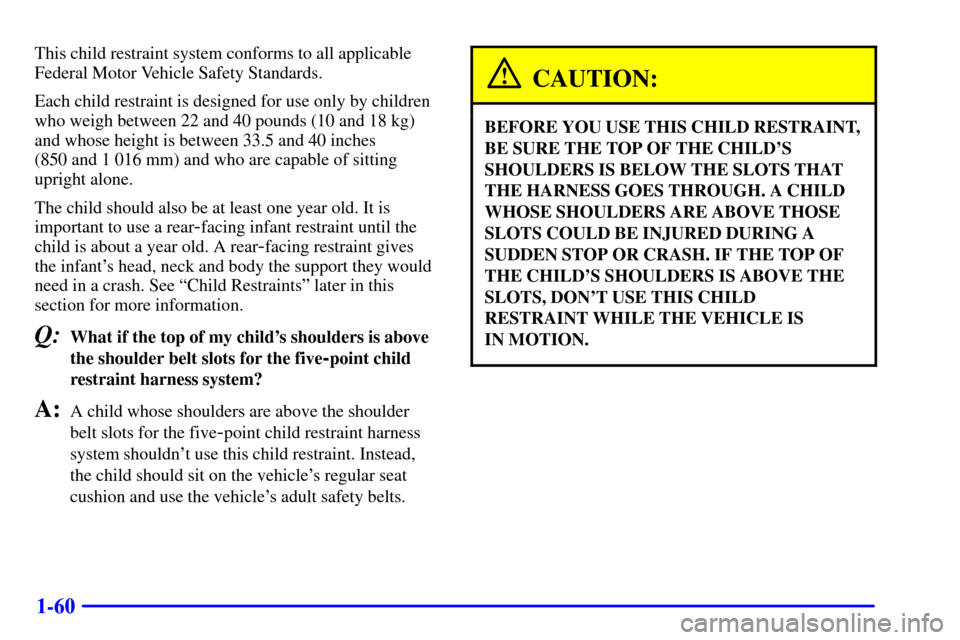
1-60
This child restraint system conforms to all applicable
Federal Motor Vehicle Safety Standards.
Each child restraint is designed for use only by children
who weigh between 22 and 40 pounds (10 and 18 kg)
and whose height is between 33.5 and 40 inches
(850 and 1 016 mm) and who are capable of sitting
upright alone.
The child should also be at least one year old. It is
important to use a rear
-facing infant restraint until the
child is about a year old. A rear
-facing restraint gives
the infant's head, neck and body the support they would
need in a crash. See ªChild Restraintsº later in this
section for more information.
Q:What if the top of my child's shoulders is above
the shoulder belt slots for the five
-point child
restraint harness system?
A:A child whose shoulders are above the shoulder
belt slots for the five
-point child restraint harness
system shouldn't use this child restraint. Instead,
the child should sit on the vehicle's regular seat
cushion and use the vehicle's adult safety belts.
CAUTION:
BEFORE YOU USE THIS CHILD RESTRAINT,
BE SURE THE TOP OF THE CHILD'S
SHOULDERS IS BELOW THE SLOTS THAT
THE HARNESS GOES THROUGH. A CHILD
WHOSE SHOULDERS ARE ABOVE THOSE
SLOTS COULD BE INJURED DURING A
SUDDEN STOP OR CRASH. IF THE TOP OF
THE CHILD'S SHOULDERS IS ABOVE THE
SLOTS, DON'T USE THIS CHILD
RESTRAINT WHILE THE VEHICLE IS
IN MOTION.
Page 73 of 429
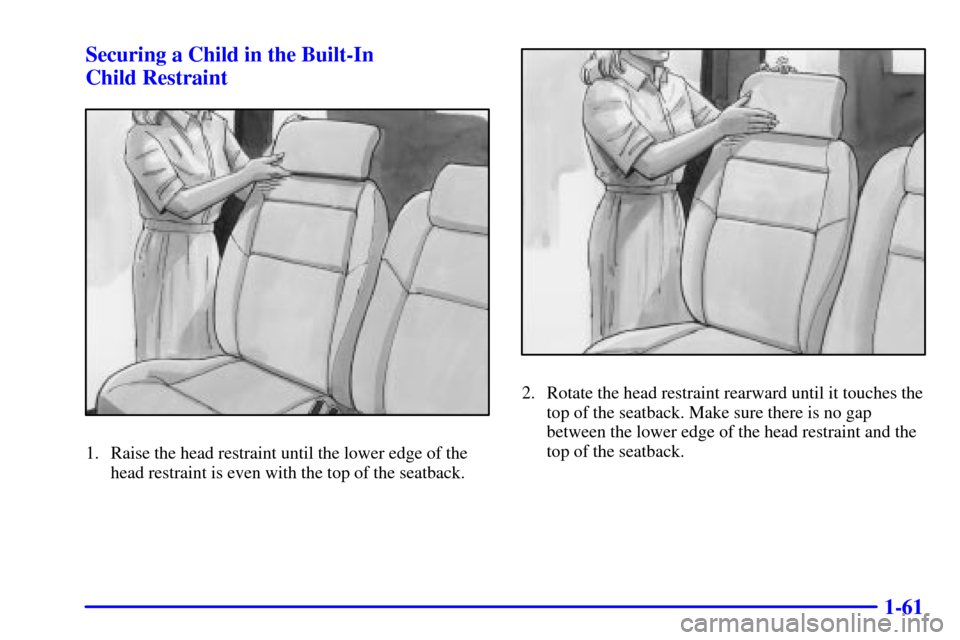
1-61 Securing a Child in the Built-In
Child Restraint
1. Raise the head restraint until the lower edge of the
head restraint is even with the top of the seatback.
2. Rotate the head restraint rearward until it touches the
top of the seatback. Make sure there is no gap
between the lower edge of the head restraint and the
top of the seatback.
Page 74 of 429
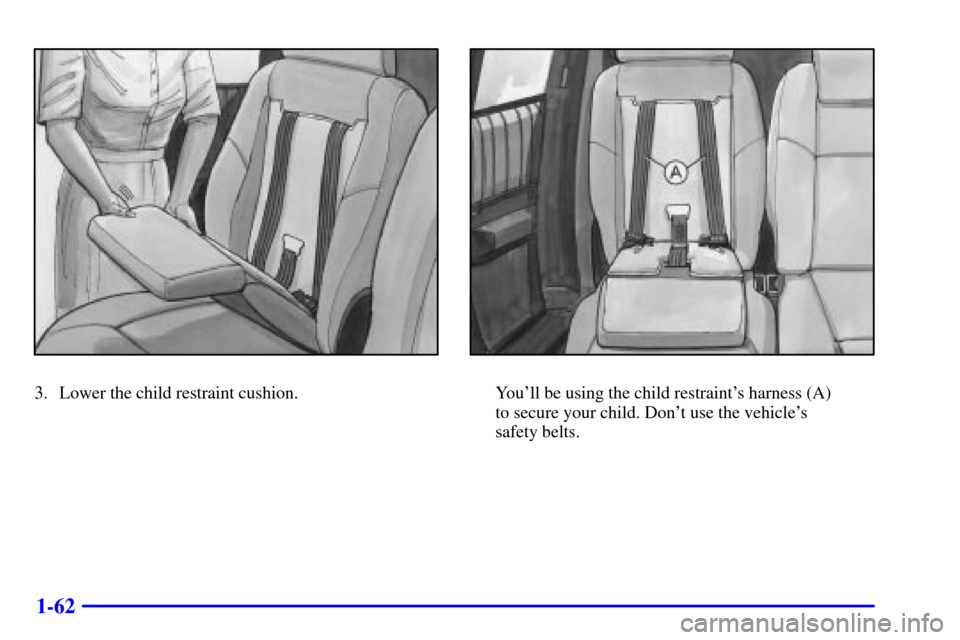
1-62
3. Lower the child restraint cushion.You'll be using the child restraint's harness (A)
to secure your child. Don't use the vehicle's
safety belts.
Page 75 of 429
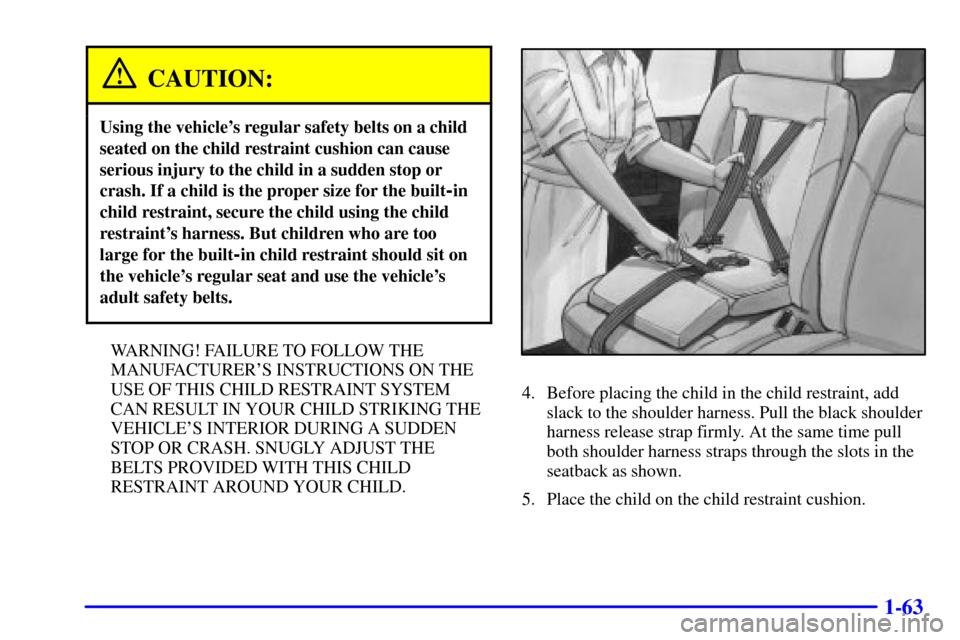
1-63
CAUTION:
Using the vehicle's regular safety belts on a child
seated on the child restraint cushion can cause
serious injury to the child in a sudden stop or
crash. If a child is the proper size for the built
-in
child restraint, secure the child using the child
restraint's harness. But children who are too
large for the built
-in child restraint should sit on
the vehicle's regular seat and use the vehicle's
adult safety belts.
WARNING! FAILURE TO FOLLOW THE
MANUFACTURER'S INSTRUCTIONS ON THE
USE OF THIS CHILD RESTRAINT SYSTEM
CAN RESULT IN YOUR CHILD STRIKING THE
VEHICLE'S INTERIOR DURING A SUDDEN
STOP OR CRASH. SNUGLY ADJUST THE
BELTS PROVIDED WITH THIS CHILD
RESTRAINT AROUND YOUR CHILD.
4. Before placing the child in the child restraint, add
slack to the shoulder harness. Pull the black shoulder
harness release strap firmly. At the same time pull
both shoulder harness straps through the slots in the
seatback as shown.
5. Place the child on the child restraint cushion.
Page 76 of 429
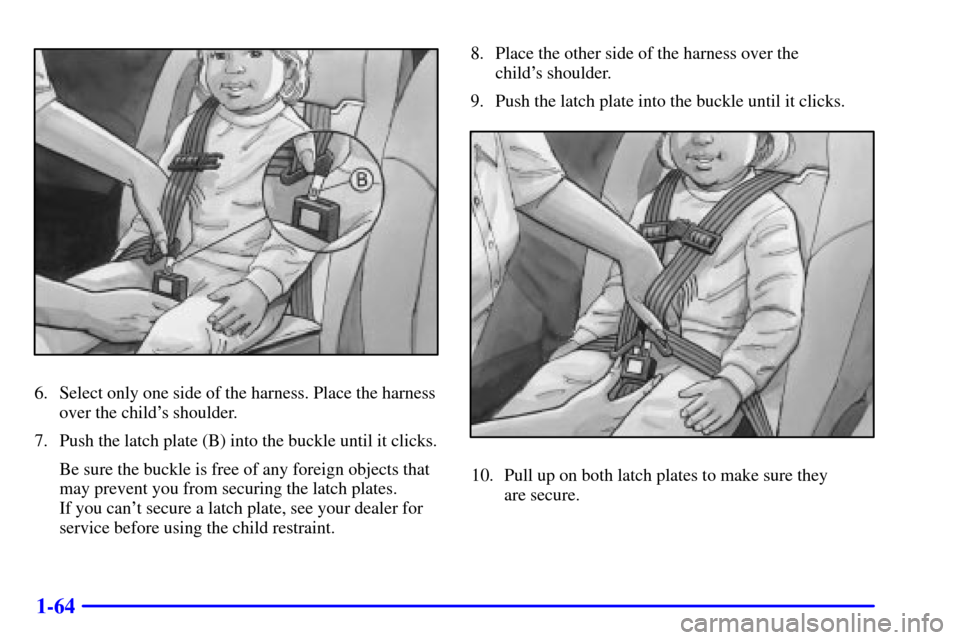
1-64
6. Select only one side of the harness. Place the harness
over the child's shoulder.
7. Push the latch plate (B) into the buckle until it clicks.
Be sure the buckle is free of any foreign objects that
may prevent you from securing the latch plates.
If you can't secure a latch plate, see your dealer for
service before using the child restraint.8. Place the other side of the harness over the
child's shoulder.
9. Push the latch plate into the buckle until it clicks.
10. Pull up on both latch plates to make sure they
are secure.
Page 79 of 429
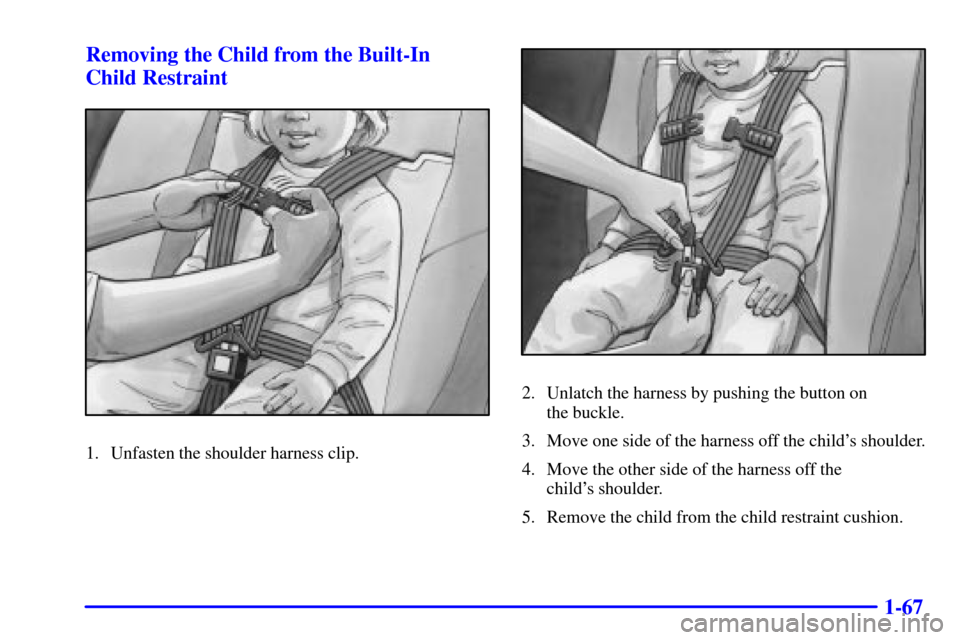
1-67 Removing the Child from the Built-In
Child Restraint
1. Unfasten the shoulder harness clip.
2. Unlatch the harness by pushing the button on
the buckle.
3. Move one side of the harness off the child's shoulder.
4. Move the other side of the harness off the
child's shoulder.
5. Remove the child from the child restraint cushion.
Page 80 of 429
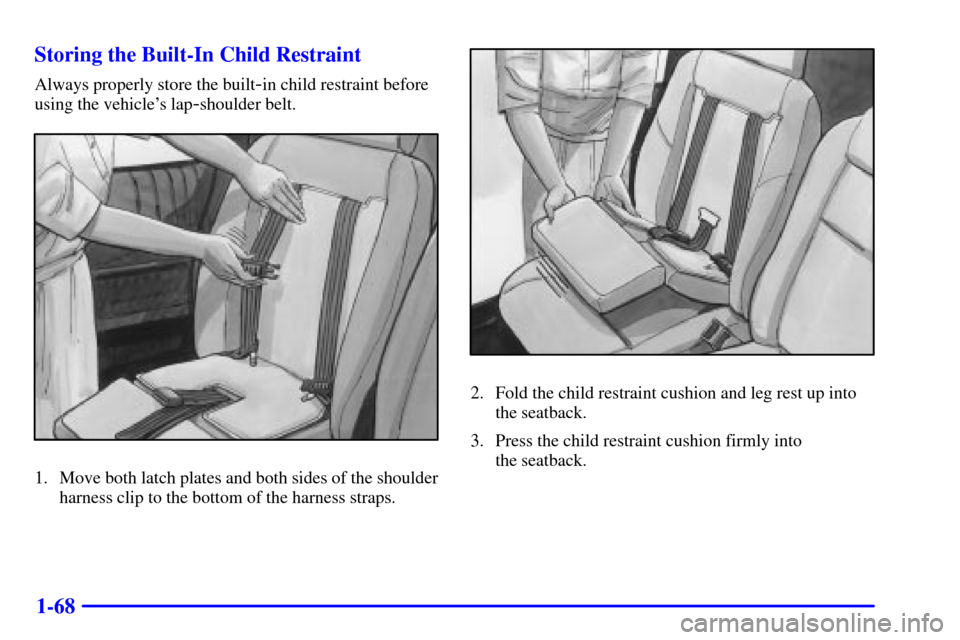
1-68 Storing the Built-In Child Restraint
Always properly store the built-in child restraint before
using the vehicle's lap
-shoulder belt.
1. Move both latch plates and both sides of the shoulder
harness clip to the bottom of the harness straps.
2. Fold the child restraint cushion and leg rest up into
the seatback.
3. Press the child restraint cushion firmly into
the seatback.
Page 81 of 429
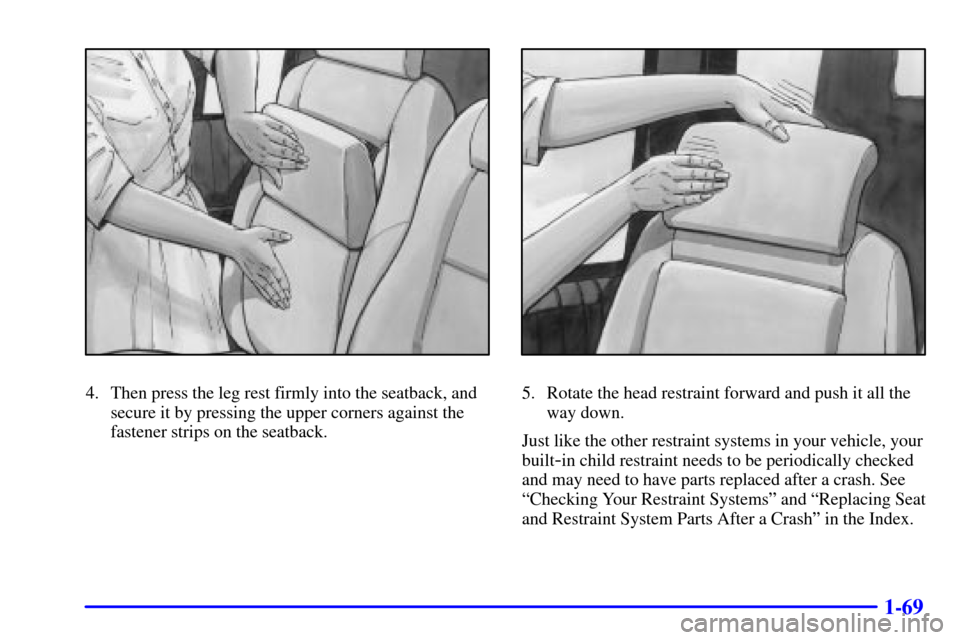
1-69
4. Then press the leg rest firmly into the seatback, and
secure it by pressing the upper corners against the
fastener strips on the seatback.5. Rotate the head restraint forward and push it all the
way down.
Just like the other restraint systems in your vehicle, your
built
-in child restraint needs to be periodically checked
and may need to have parts replaced after a crash. See
ªChecking Your Restraint Systemsº and ªReplacing Seat
and Restraint System Parts After a Crashº in the Index.